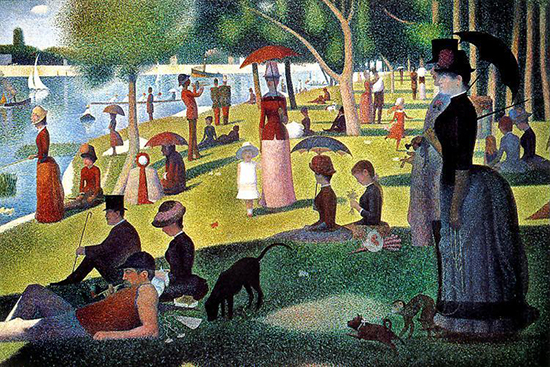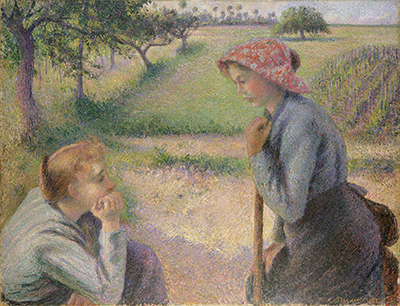Neo-Impressionism (or Pointillism or Divisionism) is an art movement founded by Georges Seurat. Followers of Neo-Impressionism, in particular, were drawn to modern urban scenes as well as landscapes and seashores. Science-based interpretation of lines and colors influenced Neo-Impressionists’ characterization of their own contemporary art. The Pointillist technique is often mentioned in this context, because it was the dominant technique in the beginning of the Neo-impressionist movement. During the emergence of Neo-Impressionism, Seurat and his followers strove to refine the impulsive and intuitive artistic mannerisms of Impressionism. Neo-impressionists used disciplined networks of dots in their desire to instill a sense of organization and permanence. In further defining the movement, Seurat incorporated the recent explanation of optic and color perceptions. The leading Neo-impressionists were Georges Seurat, Paul Signac, and Camille Pissarro.

Pointillism is a technique of painting in which small, distinct dots of pure color are applied in patterns to form an image. Georges Seurat and Paul Signac developed the technique in 1886, branching from Impressionism. The term Pointillism was first coined by art critics in the late 1880s to ridicule the works of these artists, and is now used without its earlier mocking connotation. Along with Georges Seurat, Paul Signac helped develop the pointillist style. Both Seurat and Signac were inspired by new scientific discoveries of the era that included a better understanding of color theory, optics and light. Pointillism technique also inspired Adobe Photoshop team; the team created the Pointillize filter which translates the images to pixelated dots of colors in Photoshop in 1990s.
New Pointillist Art: http://www.youtube.com/watch?v=nxBeSwlDREI
Camille Pissarro (1830–1903) was a Danish-French Impressionist and Neo-Impressionist painter born on the island of St Thomas (now in the US Virgin Islands, but then in the Danish West Indies). His importance resides in his contributions to both Impressionism and Post-Impressionism. Pissarro studied from great forerunners, including Gustave Courbet and Jean-Baptiste-Camille Corot. He later studied and worked alongside Georges Seurat and Paul Signac when he took on the Neo-Impressionist style at the age of 54.

In 1873 he helped establish a collective society of fifteen aspiring artists, becoming the “pivotal” figure in holding the group together and encouraging the other members. Art historian John Rewald called Pissarro the “dean of the Impressionist painters”, not only because he was the oldest of the group, but also “by virtue of his wisdom and his balanced, kind, and warmhearted personality”.[1] Cézanne said “he was a father for me. A man to consult and a little like the good Lord,” and he was also one of Gauguin’s masters. Renoir referred to his work as “revolutionary”, through his artistic portrayals of the “common man”, as Pissarro insisted on painting individuals in natural settings without “artifice or grandeur”.
Pissarro is the only artist to have shown his work at all eight Paris Impressionist exhibitions, from 1874 to 1886. He “acted as a father figure not only to the Impressionists” but to all four of the major Post-Impressionists, including Georges Seurat, Paul Cézanne, Vincent van Gogh and Paul Gauguin.

